Choose and Prepare your Canoe for Hunting Moose
The Canoe. By Cal
Obviously conducting a hunt like this will require some quality gear that might not be needed for other types of hunting.
The first item you are going to need is a quality, high volume tripping canoe. Because I often do solo trips I use a 16' Mad River Explorer, it’s one of the highest volume 16 foot canoes on the market and I would not want anything less.
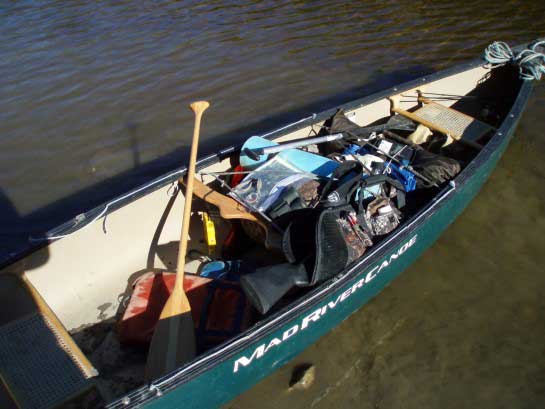
The canoe will carry two hunters, 10 days’ worth of gear, and a quartered moose... but just barely. An 18-footer would be far better suited to tandem hunts. Besides that, you are going to need a stout pack frame, a sleeping bag rated for -10 to -15 degrees Celsius, and some good rain gear.
Due to space constraints, I will not give a full list of items that I take but I will say this... your first priority is to stay warm, well fed, and keep yourself and your gear dry.
Required Supplies while Hunting from a Canoe
You should also have a knife, compass, and matches in a waterproof container on your person at all times.
Whatever hunting gear you take comes second to ensuring that these priorities are met.
For me I can get just about everything I need into a large Kelty pack and a day pack. I don't pack as light as when I'm backpacking, but I sure don't bring the kitchen sink either.
One of the major concerns that people have is; how to ensure your rifle is not lost in the event of an upset?
Just like the rest of your gear the rifle case needs to be tied into the canoe securely.
Although a hard case might seem to be the way to go, they are bulky and because of how they open, it is virtually impossible to get your rifle out quickly when the case is tied into the canoe. Use a soft case that your rifle can be drawn out of quickly without the need to untie.
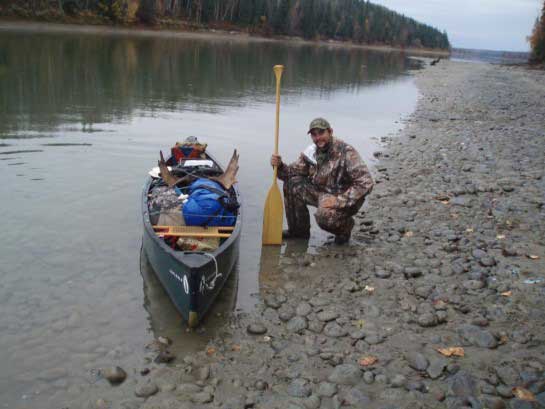
I tie the case alongside my other gear with the butt end sticking over the thwart. Often, I leave the case unzipped at the end and the butt of the rifle sticking out a bit for quick access, when I'm running rough water I'll zip up the end to ensure the rifle stays with the canoe if something goes wrong.
Although it’s not necessary, a rifle with a stainless-steel barrel is a real boon on a canoe hunt, it’s not so much that the rifle may get wet but that the case can get wet. Once the case is wet, whatever time the rifle spends in the canoe will be in a damp gun case, in this scenario if you've got a blued rifle you’re going to need to keep a diligent eye on it, as well as plenty of oil.
You should at least know how to do a proper "J" stroke, a draw, pry, and brace.
Another big question that lots of people have is; how I get a moose carcass into my canoe?
First off I quarter the moose, I don't even bother gutting it. I cut the quarters off with a hunting knife, then I make a cut down the spine and peel the hide back to get at the back-straps and ribs, once you've done this you can reach in and remove the tenderloins.
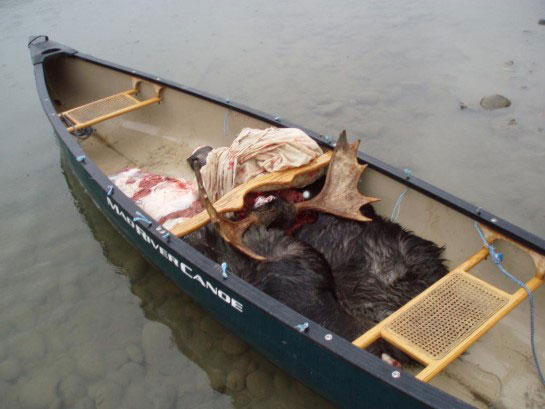
I generally use an axe to cut off the antlers and take the ribs, but for everything else I just use my hunting knife... it doesn't take any special equipment to quarter a moose.
I lay the quarters in the canoe, one hind and one front quarter in front of the center thwart, and then do the same behind the thwart so that the front and rear quarters are kitty corner to keep the load balanced. I then use the rest of the meat and the antlers to balance and trim the load properly, I cover the meat with a tarp and then tie the gear on top.
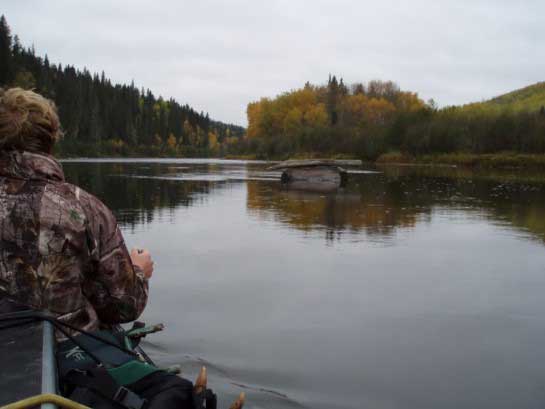
Other Major Considerations for Hunting from a Canoe
One of the things I like most about a canoe hunt is the wide variety of skills that come into play, it is like the triathlon of outdoorsmenship.
A hundred kilometers from the nearest road one is well beyond the safety net, besides hunting and canoeing you need to know how to take care of yourself if things start to get challenging... you sure can’t count on getting help from anyone else in time.
Stay in touch with loved ones or call for rescue?
A inReach Canada or inReach USA, Spot Canada or Spot USA device are very good choices to have along on these types of remote moose hunting trips.
Sometimes a trip goes off without a hitch, other times it can sorely test all the skill you can muster. Before going on a trip of this type you need to ensure that you have a good grasp of navigational, bushcraft, and survival skills.
Your ability to light a fire under challenging conditions could end up being vital if your gear somehow gets wet and the weather turns nasty.
In this age of information, I'm always amazed at how many people will paddle off on a canoe trip without bothering to learn even the most basic of canoeing skills. You should at least know how to do a proper "J" stroke, a draw, pry, and brace.
It is also vital that you know how to get back into your canoe if you flip it or fall out a long way from shore. Treat sweepers, or trees that have fallen into the water with utmost respect, because the current flows through them rather than around like most objects, you can easily get pinned in the submerged branches and drown.
Never get downstream of the canoe, between it and a rock or other solid object, this is very nearly the equivalent of placing your body in a live hydraulic press that could function at any time.
One generally doesn't need to be an expert in running white water to do a canoe hunt, if you do, you've likely picked the wrong stretch of river, but you do need to understand some basic concepts of running moving water.
One of the hardest concepts I've had getting across to inexperienced partners, is that just because you point the nose of the canoe to the left of a rock doesn't mean the canoe will actually go there. The current is sweeping you towards the obstacle and your downstream direction of propulsion further compounds this. You move much faster towards that rock than you do to the left of it and more times than not you will end up broadside on the rock you are trying to avoid. Instead you need to move across the current well before getting to the rock into a current line that will flow past the rock.
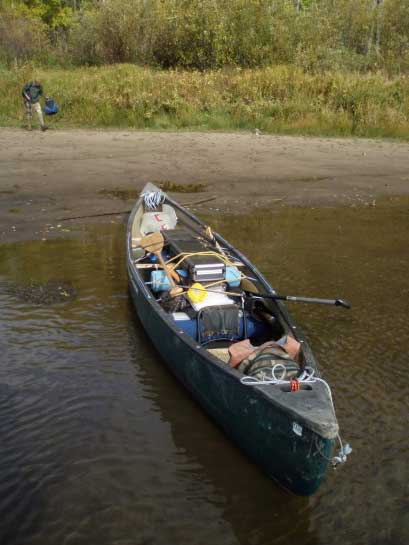
This is only the very basic core of what it takes to navigate moving water, but without understanding this you can end up wrapping your canoe around a rock even on a very easy river. A small amount of knowledge and practice can make your trip infinitely more enjoyable and safe. Fortunately, this information is widely available, and practically anyone can learn it.
Want to learn how to hunt moose? Or are you wanting to increase your moose hunting skills?
Look no further!
Our moose hunting tips book is written with
not just the novice in mind, there are tips in the book that even the
most seasoned moose hunter will find of value.
The book includes 57 chapters, with more than 150 pages of information, jam packed with tips, techniques and discussions - The Ultimate Guide to Moose Hunting!
And don't forget to order one of our Fiberglass Moose Calls. In stock and ready to ship.
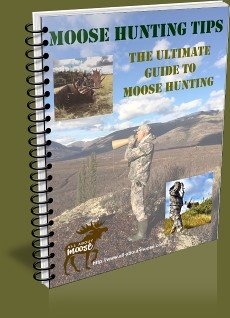
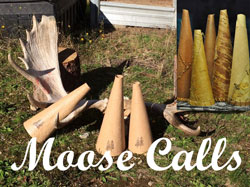
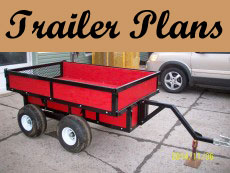
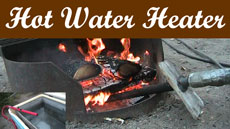
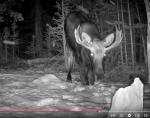
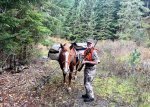
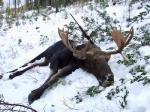
Comments
Have your say about what you just read! Leave me a comment in the box below.